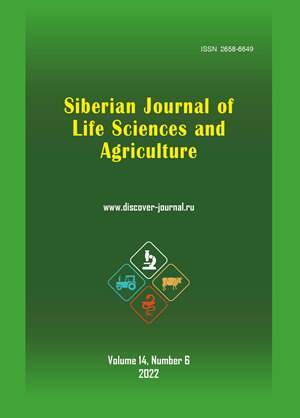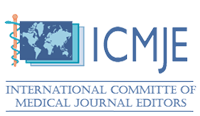ПАЛЕОЭКОЛОГИЧЕСКИЕ УСЛОВИЯ И АККУМУЛЯЦИЯ УГЛЕРОДА В ГЕНЕЗИСЕ ПОЙМЕННОГО БОЛОТА СРЕДНЕРУССКОЙ ВОЗВЫШЕННОСТИ
Аннотация
Цель – изучить влияние экологических условий на аккумуляцию углерода на разных этапах развития пойменного болота.
Материалы и методы. В образцах торфа ботанический состав и степень разложения торфов определяли микроскопическим методом, влажность и объемный вес – весовым методом. Содержание зольных элементов в торфе определяли методом сухого озоления, содержание органического вещества – по разнице между массой сухого торфа и зольностью. Содержание углерода (%) в образцах торфа рассчитывали, зная объемный вес образца, содержание органического вещества и массовой доли углерода в единице объема торфа. На основании результатов радиоактивного датирования рассчитывали скорость вертикального прироста торфа и интенсивность аккумуляции углерода в разные периоды голоцена.
Состояние окружающих ландшафтов в генезисе болота характеризовали по результатам спорово-пыльцевого анализа и пожарной активности. Интенсивность пожаров в палеоландшафтах определяли по содержанию частиц углей в каждом (1 см3) образце сырого торфа.
Результаты. В генезисе пойменного болота Подкосьмово выделено 5 стадий, формирование которых проходило в стабильных условиях водно-минерального питания. Аккумуляция углерода на всех этапах развития болота протекала со скоростью 45,7 г/м2/год в среднем. При этом, окружающие ландшафты отличались по степени облесенности и интенсивности антропогенной нагрузки.
Заключение. Умеренное увлажнение и питание минерализованными водами обеспечивает стабильность развития пойменного болота и аккумуляцию углерода, несмотря на изменение состояния окружающих ландшафтов под действием климата или человека. Однако в дальнейшем, активная трансформация окружающих ландшафтов может оказать негативное воздействие на функционирование болота и снизить интенсивность аккумуляции углерода.
Скачивания
Литература
Список литературы
Бузук Г.Н., Созинов О.В. Регрессионный анализ в фитоиндикации (на примере экологических шкал Д.Н. Цыганова) // Ботаника. Минск: Право и экономика, 2009 – Вып. 37. С. 356-362.
Волкова Е.М. Пойменные болота северо-востока Среднерусской возвышенности // Бот. Журнал, 2011. Т. 96, № 4. С. 503-514.
Волкова Е. М. Редкие болота северо-востока Среднерусской возвышенности: растительность и генезис // Бот. журн. 2011а. Т. 96. № 12. С. 1575-1590.
Волкова Е.М., Новенко Е.Ю., Юрковская Т.К. Возраст болот Среднерусской возвышенности // Известия Российской академии наук. Серия географическая. 2020. Т. 84. № 4. С. 551-561.
Гласко М. П., Гольева С. А., Сычева С. А., Бурова О. В. Ландшафты Донского побоища: возвращение утраченного // Труды Государственного исторического музея 150. 2005. С. 227–256.
Гоняный М.И., Александровский А.Л., Гласко М.П. Северная лесостепь бассейна Верхнего Дона времени Куликовской битвы. М.: ГИМ. 2007.207 с.
Кутенков С.А. Компьютерная программа для построения стратиграфических диаграмм состава торфа «Korpi» // Труды КарНЦ РАН. No 6. Сер. Экологические исследования. Петрозаводск: КарНЦ РАН, 2013. C. 171-176.
Лиштван И. И., Король Н. Т. Основные свойства торфа и методы их определения. Минск, 1975. 319 с.
Наумов А.Н., Наумова Т.В. Раскопки на селище Себино 2 Куликова поля // Археологические исследования в Центральном Черноземье. Воронеж: Полиграф. изд. «Новый взгляд», 2018. С. 193-195.
Растительность Европейской части СССР (под ред. С.А. Грибовой, Т.И. Исаченко, Е.М. Лавренко). Ленинград, Наука, 1980. 425 с.
Хмелев К.Ф. Закономерности развития болотных экосистем Центрального Черноземья. Воронеж, изд-во Воронежск. ун-та, 1985. 168 с.
Charman D. J., Amesbury M. J., Hinchliffe W, Hughes P. D. M., Mallon G, Blake W. H., Daley T. J., Gallego-Sala A. V., Mauquoy D. Drivers of Holocene peatland carbon accumulation across a climate gradient in northeastern // North America Quat. Sci. Rev. 2015, vol. 121, pp. 110–119.
Crowther T. W., Todd-Brown K. E. O., Rowe C. W., Wieder W. R. et al. Quantifying global soil carbon losses in response to warming // Nature. 2016, vol. 540, pp. 104–108. http://doi.org/10.1038/nature20150
Crill, P., Bartlett, K. and Roulet, N. Methane flux from Boreal peatlands // Suo (Mires and Peat). 1992, vol. 43 (4-5), pp. 173-182.
Dombrovskaya A. V., Koreneva M. M., Turemnov S. N. Atlas of plant remains in peat. Moscow, 1959, 228 p.
Gorham E. Northern peatlands role in the carbon cycle and probable responses to climatic warming // Ecological Applications, 1991, vol. 1, pp. 182–195. http://doi.org/10.2307/1941811
Higuera P. CharAnalysis 0.9: Diagnostic and analytical tools for sediment-charcoal analysis. Bozeman: MT, Montana State University, 2009. 27 p.
Hribljan J. A., Cooper D. J., Sueltenfuss J., Wolf E. C., Heckman K. A., Lilleskov E. A., Chimner R. A. Carbon storage and long-term rate of accumulation in high-altitude Andean peatlands of Bolivia // Mires and Peat. 2015, vol. 15(12), pp. 1–14.
Mooney S., Tinner W. The analysis of charcoal in peat and organic sediments // Mires and Peat, 2011, vol. 7. pp. 1-18.
Novenko E.Yu., Volkova E.M., Glasko M.P., Zuganova I.S. Paleoecological evidence for the middle and late Holocene vegetation, climate and land use in the upper Don River basin (Russia) // Veget. Hist. Archaeobot, 2012, vol. 21. pp. 337-352.
Novenko E.Yu., Volkova E.M. The Middle and Late Holocene Vegetation and Climate History of the Forest-steppe Ecotone Area in the Central Part of European Russia / Article of Special Issue on “Environment Evolution and Human Activity in the Late Quaternary: Geographical Pattern” // Geographical Review of Japan Series B. 2015, vol. 87(2), pp. 91-98.
Novenko E., Tsyganov A., Rudenko O., Volkova E., Zuyganova I., Babeshko K., Olchev A., Losbenev I., Payne R., Mazei Yu. Mid- and late-Holocene vegetation history, climate and human impact in the western Mid-Russian Upland: new data and a regional synthesis // Biodiversity and Conservation, 2016, pp. 2453-2472. http://doi.org/10.1007/s10531-016-1051-8
Novenko E. Yu. Landscape and climate dynamics in Central and Eastern Europe in the Holocene: paleogeographic aspects of predicting possible changes in the natural environment // Ecosystems: Ecology and Dinamics, 2020, vol. 4,pp. 57-80.
Piilo S. R., Zhang H., Garneau M., Gallego-Sala A., Amesbury M. J., Väliranta M. M. Recent peat and carbon accumulation following the Little Ice Age in northwestern Québec, Canada // Environ. Res. Lett. 2019, vol. 14, pp. 1-15. http://doi.org/10.1088/1748-9326/AB11EC
Ratcliffe J., Payne R. J. Palaeoecological studies as a source of peat depth data: A discussion and data compilation for Scotland // Mires and Peat. 2016, vol. 18(13), pp. 1–7.
Ratcliffe J., Andersen R., Anderson R., Newton A., Campbell D., Mauquoy D., Payne R. Contemporary carbon fluxes do not reflect the long-term carbon balance for an Atlantic blanket bog Holocene. 2018, vol. 28(1), pp. 140–149. http://doi.org/10.1177/0959683617715689
Reimer P. J., Bard E., Bayliss A., Beck J. W., et. Al. IntCal13 and Marine13 radiocarbon age calibration curves 0–50.000 years cal. BP // Radiocarbon. 2013, vol. 55, pp. 1869–1887. http://doi.org/10.2458/azu_js_rc.55.16947
Sheng Y., Smith L. C., MacDonald G. M., Kremenetski K. V., Frey K. E., Velichko A. A., Lee M., Beilman D. W., Dubinin P. A high-resolution GIS-based inventory of the West Siberian peat carbon pool // Global Biogeochemical Cycles, 2004, vol. 18(3), pp. 1-14. http://doi.org/10.1029/2003GB002190
Turunen J., Tomppo E., Tolonen K., Reinikainen A. Estimating carbon accumulation rates of undrained mires in Finland – application to boreal and subarctic regions // Holocene, 2002, vol. 12, pp. 69–80. http://doi.org/10.1191/0959683602hl522rp
Vorob’eva L. A. Chemical analyses of soil. Moscow: MGU, 1998, 272 p.
Yu Z. Holocene carbon flux histories of the world’s peatlands: Global carbon-cycle implications // The Holocene, 2011, vol. 21(5), pp. 761–774. http://doi.org/10.1177/0959683610386982
References
Buzuk G.N., Sozinov O.V. Regressionnyy analiz v fitoindikatsii (na primere ekologicheskikh shkal D.N. Tsyganova) [The regression analysis in phytoindication (on the example of D.N. Tsyganov’s ecological scales)]. Botanika. Minsk: Pravo i ekonomika, 2009, no. 37, pp. 356-362.
Volkova E.M. Poymennye bolota severo-vostoka Srednerusskoy vozvyshennosti [The unundated mires of north-east of the Srednerusskaya hill]. Bot. Zhurnal, 2011, vol. 96, no. 4, pp. 503-514.
Volkova E. M. Redkie bolota severo-vostoka Srednerusskoy vozvyshennosti: rastitel’nost’ i genezis [The rare mires of the North-eastern of Central Russian Upland: vegetation and genesis]. Bot. Zhurnal, 2011, vol. 96, no. 12, pp. 1575-1590.
Volkova E.M., Novenko E.Yu., Yurkovskaya T.K. Vozrast bolot Srednerusskoy vozvyshennosti [The age of mires of the Central Russian Upland]. Izvestiya Rossiyskoy akademii nauk. Seriya geograficheskaya, 2020, vol. 84, no. 4, pp. 551-561.
Glasko M. P., Gol’eva S. A., Sycheva S. A., Burova O. V. Landshafty Donskogo poboishcha: vozvrashchenie utrachennogo [Landscapes of the Don massacre: the return of the lost]. Trudy Gosudarstvennogo istoricheskogo muzeya 150, 2005, pp. 227–256.
Gonyanyy M.I., Aleksandrovskiy A.L., Glasko M.P. Severnaya lesostep’ basseyna Verkhnego Dona vremeni Kulikovskoy bitvy [Northern forest-steppe of the Upper Don basin during the Battle of Kulikovo]. M.: GIM, 2007, 207 p.
Kutenkov S.A. Komp’yuternaya programma dlya postroeniya stratigraficheskikh diagramm sostava torfa «Korpi» [Computer program for constructing stratigraphic diagrams of peat composition “Korpi”]. Trudy KarNTs RAN. No 6. Ser. Ekologicheskie issledovaniya. Petrozavodsk: KarNTs RAN, 2013, pp. 171-176.
Lishtvan I. I., Korol’ N. T. Osnovnye svoystva torfa i metody ikh opredeleniya [The main properties of peat and methods of their determination]. Minsk, 1975, 319 p.
Naumov A.N., Naumova T.V. Raskopki na selishche Sebino 2 Kulikova polya [Excavations near the village of Sebino 2 of Kulikovo field]. Arkheologicheskie issledovaniya v Tsentral’nom Chernozem’e [Archaeological research in the Central Chernozem region]. Voronezh: Poligraf. izd. «Novyy vzglyad», 2018, pp. 193-195.
Rastitel’nost’ Evropeyskoy chasti SSSR [Vegetation of the European part of the USSR] (pod red. S.A. Gribovoy, T.I. Isachenko, E.M. Lavrenko). Leningrad, Nauka, 1980, 425 p.
Khmelev K.F. Zakonomernosti razvitiya bolotnykh ekosistem Tsentral’nogo Chernozem’ya [The patterns of development of swamp ecosystems of the Central Chernozem region]. Voronezh, izd-vo Voronezhsk. un-ta, 1985, 168 p.
Charman D. J., Amesbury M. J., Hinchliffe W, Hughes P. D. M., Mallon G, Blake W. H., Daley T. J., Gallego-Sala A. V., Mauquoy D. Drivers of Holocene peatland carbon accumulation across a climate gradient in northeastern. North America Quat. Sci. Rev. 2015, vol. 121, pp. 110–119.
Crowther T. W., Todd-Brown K. E. O., Rowe C. W., Wieder W. R. et al. Quantifying global soil carbon losses in response to warming. Nature, 2016, vol. 540, pp. 104–108. http://doi.org/10.1038/nature20150
Crill, P., Bartlett, K. and Roulet, N. Methane flux from Boreal peatlands. Suo (Mires and Peat), 1992, vol. 43 (4-5), pp. 173-182.
Dombrovskaya A. V., Koreneva M. M., Turemnov S. N. Atlas of plant remains in peat. Moscow, 1959, 228 p.
Gorham E. Northern peatlands role in the carbon cycle and probable responses to climatic warming. Ecological Applications, 1991, vol. 1, pp. 182–195. http://doi.org/10.2307/1941811
Higuera P. CharAnalysis 0.9: Diagnostic and analytical tools for sediment-charcoal analysis. Bozeman: MT, Montana State University, 2009, 27 p.
Hribljan J. A., Cooper D. J., Sueltenfuss J., Wolf E. C., Heckman K. A., Lilleskov E. A., Chimner R. A. Carbon storage and long-term rate of accumulation in high-altitude Andean peatlands of Bolivia. Mires and Peat, 2015, vol. 15(12), pp. 1–14.
Mooney S., Tinner W. The analysis of charcoal in peat and organic sediments. Mires and Peat, 2011, vol. 7, pp. 1-18.
Novenko E.Yu., Volkova E.M., Glasko M.P., Zuganova I.S. Paleoecological evidence for the middle and late Holocene vegetation, climate and land use in the upper Don River basin (Russia). Veget. Hist. Archaeobot, 2012, vol. 21, pp. 337-352.
Novenko E.Yu., Volkova E.M. The Middle and Late Holocene Vegetation and Climate History of the Forest-steppe Ecotone Area in the Central Part of European Russia / Article of Special Issue on “Environment Evolution and Human Activity in the Late Quaternary: Geographical Pattern”. Geographical Review of Japan Series B, 2015, vol. 87(2), pp. 91-98.
Novenko E., Tsyganov A., Rudenko O., Volkova E., Zuyganova I., Babeshko K., Olchev A., Losbenev I., Payne R., Mazei Yu. Mid- and late-Holocene vegetation history, climate and human impact in the western Mid-Russian Upland: new data and a regional synthesis. Biodiversity and Conservation, 2016, pp. 2453-2472. http://doi.org/10.1007/s10531-016-1051-8
Novenko E. Yu. Landscape and climate dynamics in Central and Eastern Europe in the Holocene: paleogeographic aspects of predicting possible changes in the natural environment. Ecosystems: Ecology and Dinamics, 2020, vol. 4, pp. 57-80.
Piilo S. R., Zhang H., Garneau M., Gallego-Sala A., Amesbury M. J., Väliranta M. M. Recent peat and carbon accumulation following the Little Ice Age in northwestern Québec, Canada. Environ. Res. Lett., 2019, vol. 14, pp. 1-15. http://doi.org/10.1088/1748-9326/AB11EC
Ratcliffe J., Payne R. J. Palaeoecological studies as a source of peat depth data: A discussion and data compilation for Scotland. Mires and Peat, 2016, vol. 18(13), pp. 1–7.
Ratcliffe J., Andersen R., Anderson R., Newton A., Campbell D., Mauquoy D., Payne R. Contemporary carbon fluxes do not reflect the long-term carbon balance for an Atlantic blanket bog. Holocene, 2018, vol. 28 (1), pp. 140–149. http://doi.org/10.1177/0959683617715689
Reimer P. J., Bard E., Bayliss A., Beck J. W., et. Al. IntCal13 and Marine13 radiocarbon age calibration curves 0–50.000 years cal. BP. Radiocarbon. 2013, vol. 55, pp. 1869–1887. http://doi.org/10.2458/azu_js_rc.55.16947
Sheng Y., Smith L. C., MacDonald G. M., Kremenetski K. V., Frey K. E., Velichko A. A., Lee M., Beilman D. W., Dubinin P. A high-resolution GIS-based inventory of the West Siberian peat carbon pool. Global Biogeochemical Cycles, 2004, vol. 18(3), pp. 1-14. http://doi.org/10.1029/2003GB002190
Turunen J., Tomppo E., Tolonen K., Reinikainen A. Estimating carbon accumulation rates of undrained mires in Finland – application to boreal and subarctic regions. Holocene, 2002, vol. 12, pp. 69–80. http://doi.org/10.1191/0959683602hl522rp
Vorob’eva L. A. Chemical analyses of soil. Moscow: MGU, 1998, 272 p.
Yu Z. Holocene carbon flux histories of the world’s peatlands: Global carbon-cycle implications. The Holocene, 2011, vol. 21(5), pp. 761–774. http://doi.org/10.1177/0959683610386982
Просмотров аннотации: 238 Загрузок PDF: 246
Copyright (c) 2023 Elena M. Volkova, Olga A. Leonova, Vasyliy V. Mironov

Это произведение доступно по лицензии Creative Commons «Attribution-NonCommercial-NoDerivatives» («Атрибуция — Некоммерческое использование — Без производных произведений») 4.0 Всемирная.





















































